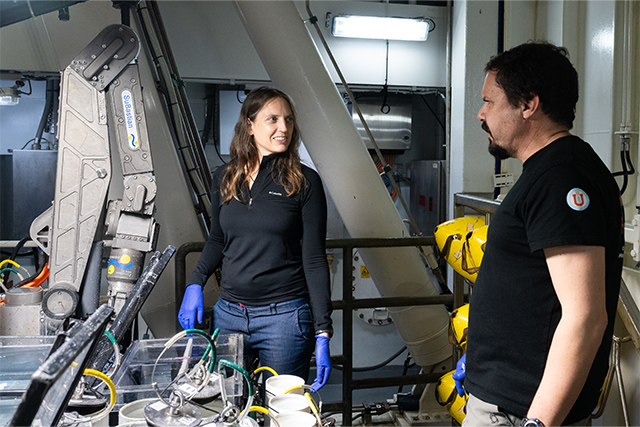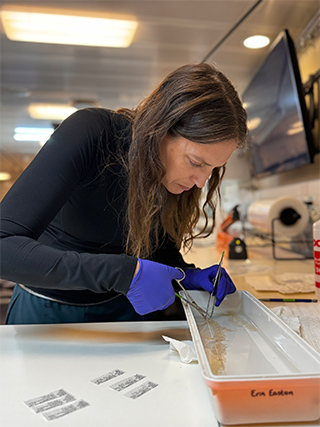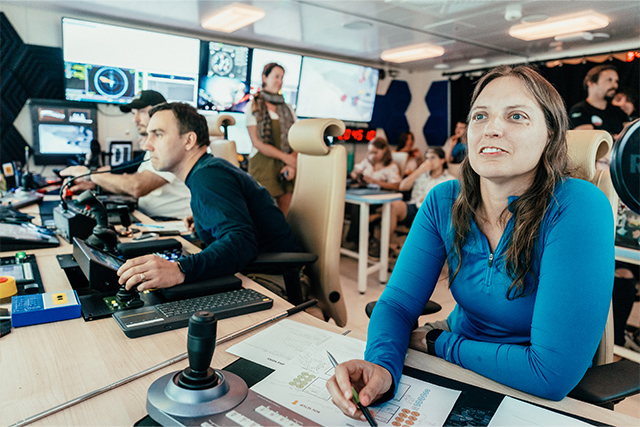By Amanda A. Taylor-Uchoa
RIO GRANDE VALLEY, TEXAS – FEB. 12, 2025 – When Dr. Erin Easton, an assistant professor with the UTRGV School of Earth, Environmental and Marine Sciences, first opened the email congratulating her on winning The Explorers Club Citation of Merit, she was aboard a Schmidt Ocean Institute research vessel braving icy Antarctic seas.
Cut off from reliable communication and surrounded by ice flows, it took a moment for her to process the shock of the news.
“I was like, is this real? Like how?” Easton recalled. “I read the email, and I was just blown away. I immediately sent a semi-coherent message to my collaborator, Dr. Javier Sellanes, telling him he needed to check his email and read it.”
Founded in 1904, The Explorers Club has honored some of the world’s most extraordinary achievements in exploration, from the first summit of Mount Everest to the Apollo Moon landings.
Both Easton and Sellanes have received the Citation of Merit, one of the Club’s prestigious annual awards, recognizing Easton’s groundbreaking deep-sea expeditions and her collaborative work with Chilean scientist Sellanes. Together, they have ventured into uncharted waters – literally – revealing marine ecosystems never seen before.
A SURPRISING HONOR
The Explorers Club Citation of Merit has honored legendary trailblazers such as NASA administrator James Webb and Titanic discoverer Dr. Robert Ballard – an explorer who inspired Easton as a young student.
“I read a book by Robert Ballard when I was about eight or nine years old,” Easton said. “He discovered the Titanic and got the same award [from The Explorers Club] in 1986. That book inspired me to go into deep-sea research … so it’s an interesting, almost full-circle moment.”
While Easton’s expeditions didn’t involve historic shipwrecks, they did uncover an array of new marine species from largely uncharted corners of the Pacific. She and Sellanes have identified potentially hundreds of previously unknown organisms living on seamounts and in deep-sea habitats off the coast of Chile.
“My understanding is it’s based on our expeditions last year … going to areas that hadn’t really been explored, with a remotely operated vehicle and discovering potentially hundreds of new species,” she said. “It never crossed my mind that we could get this award.”
EXPLORING THE UNEXPLORED
Despite rough seas and unpredictable ice, Easton said her current expedition off the coast of Antarctica perfectly illustrates the spirit of exploration that led to her award.
“I think most of the area that we’re doing the studies in, no one has done scientific studies there before,” Easton said. “We’re trying to go fairly far south off the coast of Antarctica. Right now, there’s a break in the ice and we’re heading toward our stations that are in this break.”
Onboard is a specialized “ice pilot,” crucial for navigating polar-rated vessels through regions filled with seasonal sea ice. Although Easton’s research vessel is not a full-fledged icebreaker, it can maneuver around – and occasionally through – first-year ice, which makes this high-latitude science possible.
“We have an ice pilot, who you’re required to have in these areas so they know what’s happening with the ice,” she explained. “We can’t go into multi-year ice, but we can manage first-year ice. There’s always a certain level of danger in any situation, any expedition.”
This current expedition, led by Schmidt Ocean Institute, embarked on Jan. 10 and will return to land on Feb. 13. Easton plans to spend about a week on land before heading out again on another expedition toward the South Sandwich Islands in the southern Atlantic Ocean, a British Overseas Territory.
TEAM EFFORT AND NEXT STEPS
A crucial part of Easton’s work involves collaboration with local communities, students and international research teams. She emphasized that every expedition relies on a broad network of experts, from ocean mappers to local guides and Indigenous stakeholders.
“We had a lot of students, and seeing how hard they work to help us achieve the goals was amazing,” Easton said. “You have this whole team supporting you; you’re never alone in what you do.”
Looking ahead, she hopes to secure funding to continue analyzing the many samples her team has collected – and to bring more students from UTRGV on future voyages.
“If I could just spend all day training students and taking them out on expeditions, I’d be a happy person,” she said with a laugh.
ACCEPTING THE AWARD
Although her field schedule is hectic, Easton and Sellanes plan to travel to New York City in April 2025 for The Explorers Club’s annual gala, where they will formally receive the Citation of Merit. She said the moment feels surreal, especially when reflecting on the explorers honored before her.
“We knew we were exploring under-studied areas, but, I guess, I never really thought of myself on the same level as some of these people who did these amazing ‘firsts,’” Easton said. “To be seen that way by others is pretty amazing.”
After learning that her childhood inspiration, Ballard, once received the same accolade, Easton joked that her younger self would be in utter disbelief.
“It’s pretty amazing,” she said. “Never crossed my mind that we could get this award.”
Amid the endless gray seas of Antarctica, Easton will soon join the ranks of those pushing the boundaries of human knowledge – one unknown journey at a time.
To learn more about Easton and her expeditions with UTRGV students, visit this link. Read more about ther Citation of Merit here.
ABOUT UTRGV
The University of Texas Rio Grande Valley (UTRGV) was created by the Texas Legislature in 2013 as the first major public university of the 21st century in Texas. This transformative initiative provided the opportunity to expand educational opportunities in the Rio Grande Valley, including a new School of Medicine and a School of Podiatry, and made it possible for residents of the region to benefit from the Permanent University Fund – a public endowment contributing support to the University of Texas System and other institutions.
UTRGV has campuses and off-campus research and teaching sites throughout the Rio Grande Valley including Brownsville (formerly The University of Texas at Brownsville campus), Edinburg (formerly The University of Texas-Pan American campus), Harlingen, Weslaco, McAllen, Port Isabel, Rio Grande City and South Padre Island. UTRGV, a comprehensive academic institution, enrolled its first class in the fall of 2015; the School of Medicine welcomed its first class in the summer of 2016, and the School of Podiatric Medicine in the fall of 2022.




